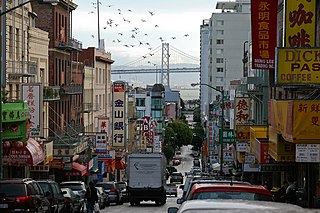
The Chinatown centered on Grant Avenue and Stockton Street in San Francisco, California, is the oldest Chinatown in North America and one of the largest Chinese enclaves outside Asia. It is also the oldest and largest of the four notable Chinese enclaves within San Francisco. Since its establishment in the early 1850s, it has been important and influential in the history and culture of ethnic Chinese immigrants in North America. Chinatown is an enclave that has retained its own customs, languages, places of worship, social clubs, and identity.
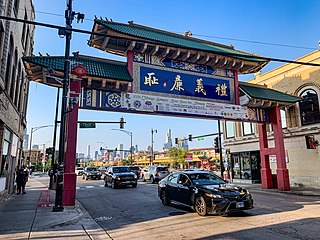
Chinatown is a neighborhood on the South Side of Chicago, along S. Wentworth Avenue between Cermak Road and W. 26th St. Over a third of Chicago's Chinese population resides in this ethnic enclave, making it one of the largest concentrations of Chinese-Americans in the United States. It formed around 1912, after settlers moved south from near the Loop, where the first enclaves were established in the 19th century.

Bourbon Street is a historic street in the heart of the French Quarter of New Orleans. Extending twelve blocks from Canal Street to Esplanade Avenue, Bourbon Street is famous for its many bars and strip clubs.
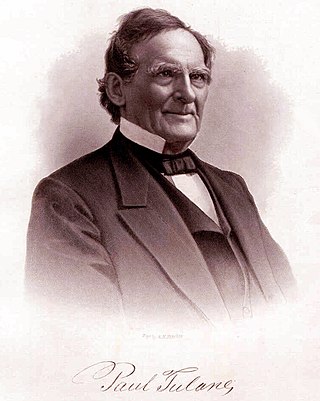
Paul Tulane was an American philanthropist and donor. Born in Cherry Valley, near Princeton, New Jersey, to a prominent French merchant family, Tulane made his fortune from a retail and dry goods company. Later, he became one of New Orleans' most prominent pro-confederate philanthropists and the namesake of Tulane University, formerly known as the Medical College of Louisiana.

Calgary's Chinatown is a district of Calgary located along Centre Street in the southeast area of Downtown Calgary immediately west of the Downtown East Village. Calgary's Chinese Cultural Centre, with its traditional architecture and decor, is largest facility of its kind in North America. It serves the Chinese community of Calgary and provides educational and cultural programs for the wider community and its visitors.). The Dragon City Mall and Sien Lok Park are also located in this district.

Philadelphia Chinatown is a predominantly Asian American neighborhood in Center City, Philadelphia, Pennsylvania. The Philadelphia Chinatown Development Corporation supports the area. The neighborhood stretches from Vine Street on the north, Arch Street on the south, North Franklin Street and N. 7th Street on the east, to North Broad Street on the west.

The St. Charles Streetcar Line is a historic streetcar line in New Orleans, Louisiana. Running since 1835, it is the oldest continuously operating streetcar line in the world. It is operated by the New Orleans Regional Transit Authority (RTA). Officially the St. Charles Streetcar line is designated as Route 12, and it runs along its namesake, St. Charles Avenue. It is the busiest route in the RTA system as it is heavily used by local commuters and tourists. On most RTA maps and publications, it is denoted in green, which is also the color of the streetcars on this line.
The 4th Ward or Fourth Ward is a division of the city of New Orleans, Louisiana, United States, one of the 17 Wards of New Orleans.
Lew Hing (formal married name was Lew Yu-ling; Chinese: 劉興; May 1858–March 7, 1934) was a Chinese-born American industrialist and banker. He was one of the founding fathers of the "New Chinatown" following the San Francisco Earthquake of 1906. As well, he was an important leader in the establishment of Chinatown in Oakland, California. He was known to be one of the wealthiest Chinese immigrants in America.

The Energy Centre, located in the Central Business District of New Orleans, Louisiana, is a 39-story, 530 feet (162 m) -tall skyscraper designed by HKS, Inc. It is the fourth tallest building in both the city of New Orleans and the state of Louisiana.

Chinatown is an neighbourhood in Winnipeg, Manitoba, that was formed in 1909 and serves as an enclave of Chinese expatriates.
Los Angeles Street, originally known as Calle de los Negros is a major thoroughfare in Downtown Los Angeles, California, dating back to the origins of the city as the Pueblo de Los Ángeles.
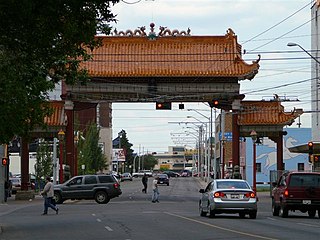
Chinatown and Little Italy is a business revitalization zone (BRZ) created by the City of Edmonton, roughly comprising the informal Chinatown and Little Italy ethnic enclaves in the city's inner neighbourhoods. The boundaries of the BRZ includes only the "commercial strips" within those enclaves and the BRZ itself straddles the official neighbourhoods of McCauley and Boyle Street.

Chinatowns are enclaves of Chinese people outside of China. The first Chinatown in the United States was San Francisco's Chinatown in 1848, and many other Chinatowns were established in the 19th century by the Chinese diaspora on the West Coast. By 1875, Chinatowns had emerged in eastern cities such as New York City, Boston, Pittsburgh, and Philadelphia. The Chinese Exclusion Act of 1882 barred Chinese immigration to the United States, but the Magnuson Act of 1943 repealed it, and the population of Chinatowns began to rise again.

The U.S. city of Baltimore, Maryland is home to a small Chinatown. Historically, Baltimore had at least two districts that were called "Chinatown" where the first one existed on the 200 block of Marion Street during the 1880s. A second and current location is at the 300 block of Park Ave., which was dominated by laundries and restaurants. The initial Chinese population came because of the transcontinental railroad, however, the Chinese population never exceeded 400 as of 1941. During segregation, Chinese children were classified as "white" and went to the white schools. Chinatown was largely gone by the First World War due to urban renewal. Although Chinatown was largely spared from the riots of the 1960s, most of the Chinese residents moved to the suburbs. As of 2009, the area still shows signs of blight and does not have a Chinese arch. As of 2017, the area has become an “immigration hub” for Ethiopian people. In 2018, a mural of a Chinese dragon and an African lion was painted to signify the past as a Chinatown and the present as an African neighborhood. A night market in September 2018 marked the first Asian celebration of the area to an area that was “long forgotten and neglected”.

A Chinatown developed in Phoenix in the 1870s as the predominantly single male Chinese population self-segregated primarily to provide cultural support to each other in a place where they faced significant discrimination. They came to dominate certain types of jobs and made an impression on the greater community with their celebrations of Chinese holidays. Other aspects of their culture, primarily gambling and the smoking of opium were viewed less favorably, and in the 1890s, they were forced to establish a new Chinatown several blocks away from the prior prime downtown location, where their community would be "less visible".
The Chicago metropolitan area has an ethnic Chinese population. While historically small in comparison to populations on the coasts, the community is rapidly expanding. As of 2023, there are 78,547 Chinese Americans who live in Chicago, comprising 2.9% of the city's population, along with over 150,000 Chinese in the greater Chicago area - making Chicago's Chinese community the 8th largest among US metropolitan areas. This population includes native-born Chinese as well as immigrants from Mainland China, Taiwan, Hong Kong and Southeast Asia, and also racially mixed Chinese.
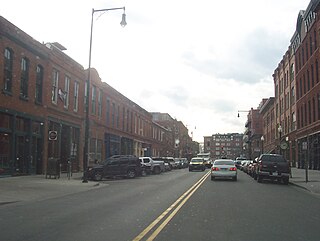
Chinatown in Denver, Colorado, was a residential and business district of Chinese Americans in what is now the LoDo section of the city. It was also referred to as "Hop Alley", based upon a slang word for opium. The first Chinese resident of Denver, Hong Lee, arrived in 1869 and lived in a shanty at Wazee and F Streets and ran a washing and ironing laundry business. More Chinese immigrants arrived in the town the following year. Men who had worked on the construction of the first transcontinental railroad or had been miners in California crossed over the Rocky Mountains after their work was completed or mines were depleted in California.

First Chinatown is a retronym for a former neighbourhood in Toronto, an area that once served as the city's Chinatown. The city's original Chinatown existed from the 1890s to the 1970s, along York Street and Elizabeth Street between Queen and Dundas Streets within St. John's Ward. However, more than two thirds of it was expropriated and razed starting in the late 1950s to build the new Toronto City Hall and its civic square, Nathan Phillips Square.

















